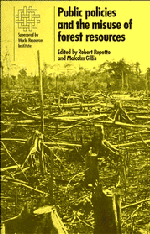Book contents
- Frontmatter
- Contents
- Contributors
- Foreword
- Acknowledgments
- 1 Overview
- 2 Indonesia: public policies, resource management, and the tropical forest
- 3 Malaysia: public policies and the tropical forest
- 4 Incentive policies and forest use in the Philippines
- 5 Price and policy: the keys to revamping China's forestry resources
- 6 Public policy and deforestation in the Brazilian Amazon
- 7 West Africa: resource management policies and the tropical forest
- 8 Subsidized timber sales from national forest lands in the United States
- 9 Conclusion: findings and policy implications
- Index of Topics
8 - Subsidized timber sales from national forest lands in the United States
Published online by Cambridge University Press: 06 July 2010
- Frontmatter
- Contents
- Contributors
- Foreword
- Acknowledgments
- 1 Overview
- 2 Indonesia: public policies, resource management, and the tropical forest
- 3 Malaysia: public policies and the tropical forest
- 4 Incentive policies and forest use in the Philippines
- 5 Price and policy: the keys to revamping China's forestry resources
- 6 Public policy and deforestation in the Brazilian Amazon
- 7 West Africa: resource management policies and the tropical forest
- 8 Subsidized timber sales from national forest lands in the United States
- 9 Conclusion: findings and policy implications
- Index of Topics
Summary
Background
The U.S. National Forest system includes 191 million acres of forest land, more than a quarter of the national total. Because timber production in the past drew more heavily on accessible, higher quality stands owned by private industry, the national forests contain a much higher fraction of standing sawtimber stocks, almost one-half. Much of this is mature, old-growth timber or grows on relatively low productivity sites, so despite a large increase in harvesting between 1940 and 1965, the national forests' contribution to annual net timber growth and harvest is more in line with their share in forest area. The national forests are also prime recreation areas, attracting more than 225 million visitor days of recreational use each year, almost ten times as many as in 1950. In addition, national forest lands have drawn increasing attention as potential repositories of significant mineral and energy resources.
These increasing and potentially conflicting demands have ensured controversies over forest management policies (Wilkinson and Anderson 1985). Often, these have arisen over attempts to restrict the multiple-use management principles employed by the U.S. Forest Service, or to reorient the application of those principles in favor of one or another specific use. A long-standing and sharp controversy of this nature has pitted recreational and conservationist interests against the Forest Service over timber harvesting and associated road-building in areas allegedly unsuitable for commercial timber production due to inaccessibility and relatively high growing costs. Many of the areas in question are either roadless tracts potentially eligible for restrictive wilderness designation, or in regions of recreational value. While the Forest Service defends its timber operations under broader measures of multiple-use benefits and costs, critics charge that they fall far short of recovering even their direct costs and should be curtailed.
- Type
- Chapter
- Information
- Public Policies and the Misuse of Forest Resources , pp. 353 - 384Publisher: Cambridge University PressPrint publication year: 1988
- 1
- Cited by

